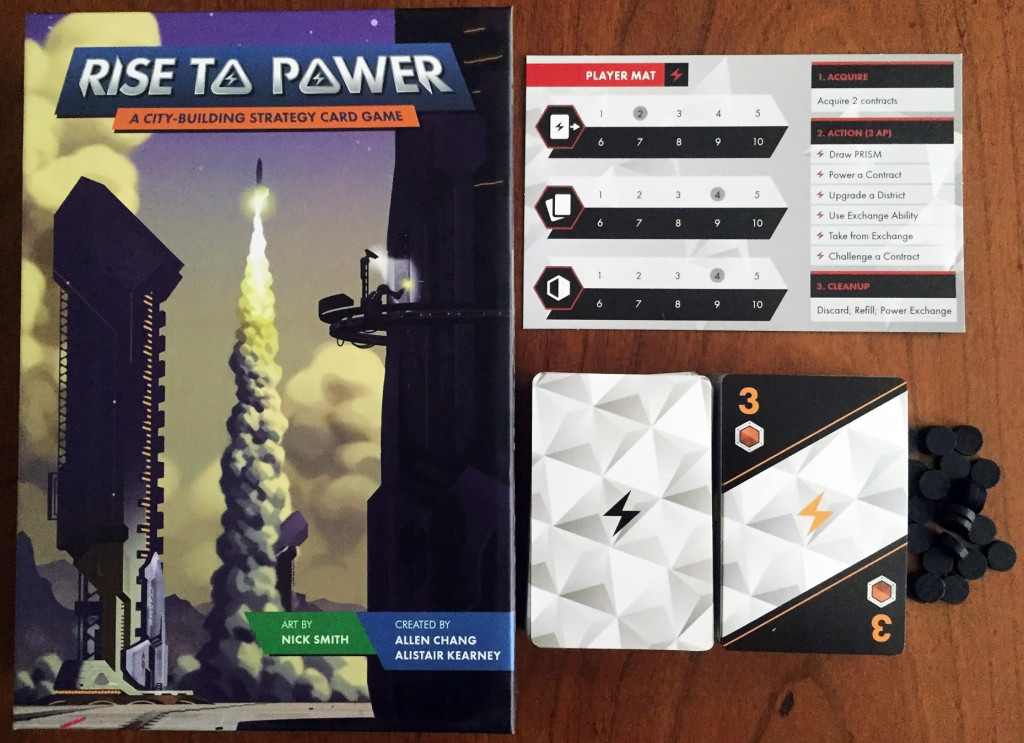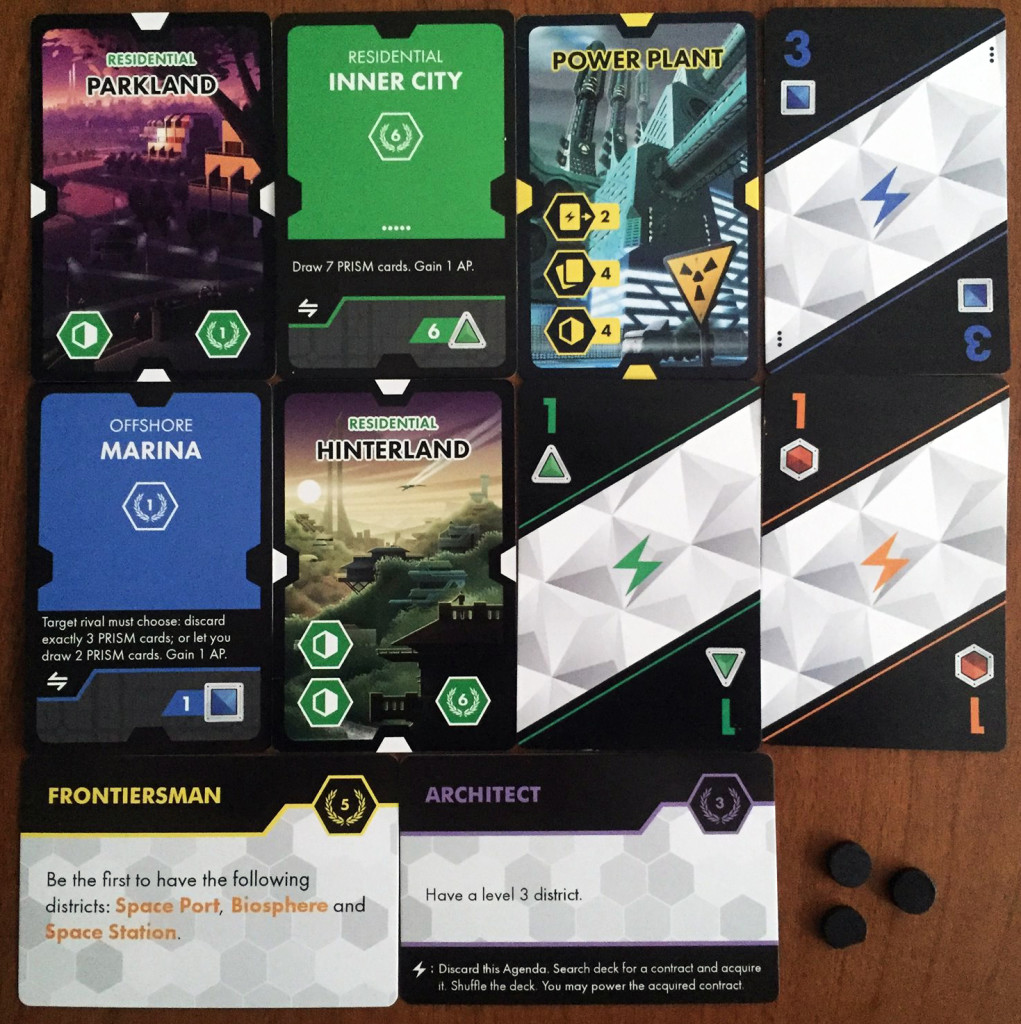“SimCity” fans know that there a few different kinds of energy: wind, coal, nuclear, and etc. You know, the kind of power we generate in today’s day and age. Enter “PRISM”, the abundant energy source featured in the city-building strategy card game, “Rise to Power”. “Rise to Power” is like SimCity but on a much simpler scale, with your objective being to use PRISM to fulfill contracts and ultimately add districts to your ever-growing city. Before we touch on the details, I’d like to thank Kevin Brusky from APE Games for providing me with a free copy for review purposes.
Components
The game includes 1 Exchange Marker, 72 PRISM Cards (3 colors, valued 1-6), 6 Power Plants, 4 Agendas, 54 Contracts (the reverse side of these cards are called Districts), 18 Attribute Markers, and 6 Player Mats. There are also 18 Government Contracts, 6 CEOs, 6 PRISM Pylons, and 4 Advanced Agendas…though these are optional expansions. To keep the review moving, I’ll opt to focus on the core game.
Setup & Gameplay
Some cards will be removed from the game, depending on the number of players (cards have pip indicators to let you know if they should be included in a 3/5 player game). The PRISM and contract decks are shuffled separately and four contracts are dealt to form the contract zone. The exchange marker is placed nearby to form its own zone. The agenda cards are shuffled and a number are dealt into its own central zone equal to the number of players. Each player gets a power plant card (placed in front of them), a player mat with three attribute markers (they are placed on the values shown on the power plant card), and two PRISM cards to form their starting hand.
A player’s turn is broken up into three phases:
1. Acquire – The player must choose two contracts from the contract zone and place them onto their grid. If a chosen contract can’t be placed legally, then this process is skipped. Contracts placed onto the grid must be done so next to a power plant or district.
2. Action – The player has two action points with which to spend on six different actions: A) power a contract, B) upgrade a district, C) draw prism, D) use exchange ability, E) take a district from the exchange, and F) challenge a contract.
3. Cleanup – The player must discard down their current PRISM limit, refill the contract zone using the contract deck, and power any contracts placed on the exchange by flipping them over.
Turns continue clockwise until a player has eight districts on their grid at the end of their turn. All other players get one more turn before the game ends. Players add the influence values from all their districts (even those that are in a stack, earning bonuses as appropriate) and whoever has the most, wins the game!
Editor’s Note: The above doesn’t cover all of the rules found in the manual, but should give you an idea as to how the game plays.
The Review
“Rise to Power” tasks players with achieving a simple goal (getting eight districts on their grid), but getting there really requires a bit of thought and strategy because of the number of different actions one can take on their turn. The act of drawing PRISM cards is a no-brainer, but doing things like challenging a district or using an exchange ability offers a fair amount of risk. When doing the former, the active player attempts to build a contract from their opponent’s grid (stealing it away from them). However, if their opponent has the cards required to complete the contract, they can quickly do so. Thus, it’s possible to goad your opponent into challenging you so that you can fulfill a contract on their turn, thereby allowing you to spend action points on something else when your turn rolls around. Using a contract’s exchange ability is also risky as while it gives you an ability to use right now, it’ll become a powered district for someone else to grab on their turn.
Upgrading contracts and the requirement of laying upgrades down in descending order keeps things interesting too. Ideally, one would want to lay down and fulfill high-valued contracts first to give them more upgrade options in the future…though fate/luck may have other ideas. Each upgrade to a district increases its level by one and in turn, provides bonus influence at the end of the game (a level 2 district earns 1 bonus influence, a level 3 district earns 2 bonus influence, and etc.). The act of powering contracts itself can be tricky, as players earn a bonus AP point for spending the exact amount of PRISM required to complete it (like in “Alhambra”). You can spend more of course, but no change is given. Powering contracts/flipping them over to their district side will in turn grant the player permanent bonuses (draw power, PRISM limit, grid limit) which can be tracked via the player mat.
Of course, I didn’t even touch on the optional expansions (government contracts, CEOs, PRISM pylons, and advanced agendas). Advanced agendas work like regular agendas for example in that they provide players with goals to shoot for. However, the former are worth three influence instead of five and have a powerful single-use ability. CEOs allow players to spend an action point to use their active trait…sort of like a unique special ability that can only be used once. After that, the CEO’s passive trait can be used for the rest of the game. PRISM pylons allow players to spend one action point to store 1 PRISM card there permanently (max 3). Each card reduces the value of PRISM costs by one, though players don’t need to use the PRISM pylon if they don’t want to. No bonus AP is awarded when using a PRISM to power a contract, for example, so if you have exact change already then it’s best not to use the PRISM pylon. Then there’s the government sector expansion, which works similarly to other contracts but with some important exceptions.
“Rise to Power” isn’t a bad game at all and I love how it can be played in about thirty minutes (if you know what you’re doing). It’s hard for me to play city-builders like “Suburbia” without going over an hour or possibly even two, mainly because I take a while to factor in all of the tiles and their special effects. “Rise to Power” eases off on the stimuli being thrown at you in that regard, which is good if you’re in the mood to play a city-builder but don’t have a lot of time to get a game in. Despite its simplicity compared to games like “Suburbia”, it’ll still make you think a bit. I couldn’t recommend it to casual gamers for that very reason, but anyone into light to moderate strategy games would do well to pick it up (especially at the $20-$25 price tag on Amazon as of 9/21/15).
Final Verdict: 7/10
—


